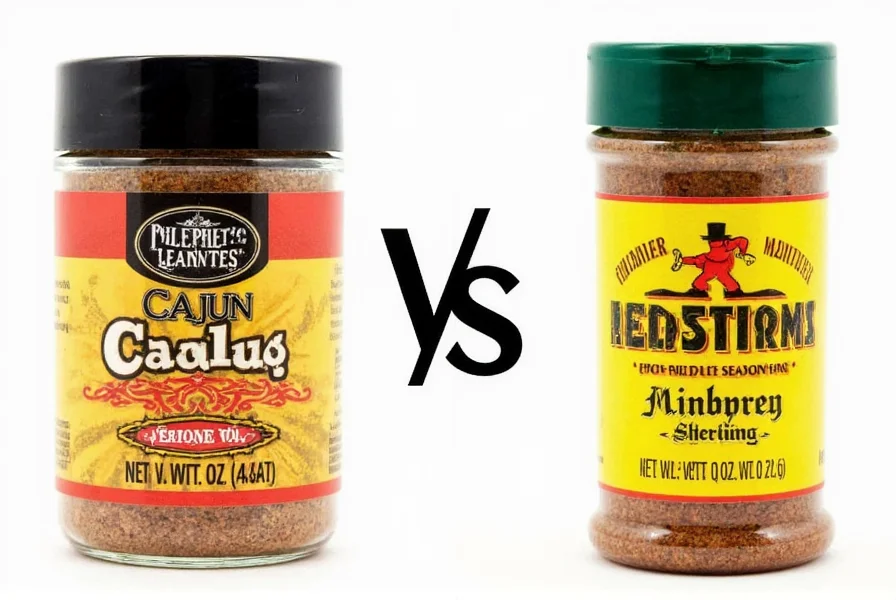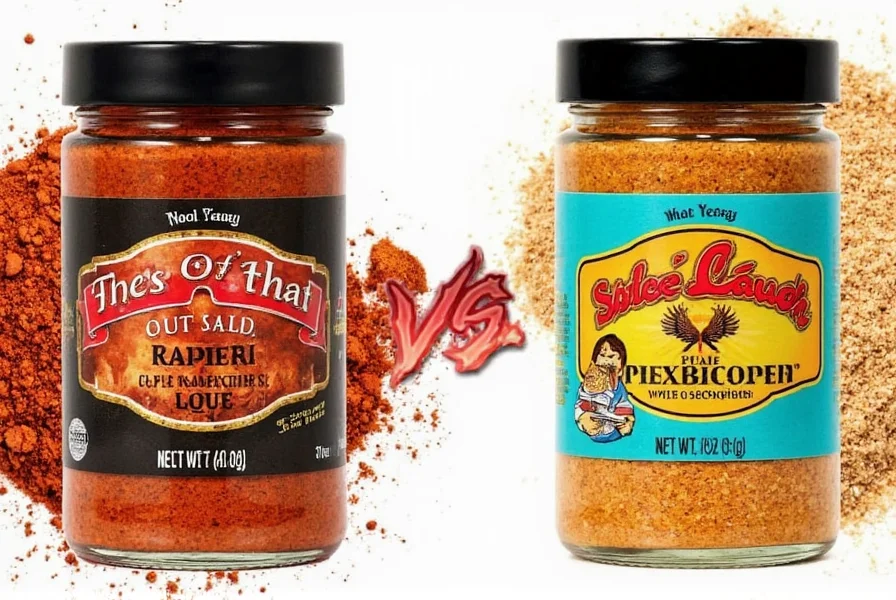Cajun vs Creole Seasoning: Spice Showdown – Which One Packs the Punch?
Calling all spice enthusiasts and curious cooks! Whether you're stirring up a gumbo or jazzing up your grilled chicken, you've probably come across two iconic Southern seasonings—Cajun and Creole. But what's the real difference between them? And more importantly, which one should you reach for when the heat is on?
Table of Contents
- A Tale of Two Spices: What Are Cajun and Creole Seasonings?
- Head-to-Head: Comparing Cajun vs Creole
- Where to Use Them: Flavor-Filled Pairings
- Buying Guide: Choosing the Best Cajun and Creole Seasonings
- Final Thoughts: Pick Your Spice Sidekick
A Tale of Two Spices: What Are Cajun and Creole Seasonings?
Though both hail from Louisiana and share some similarities, Cajun and Creole seasonings are not interchangeable. They each have distinct origins, ingredient profiles, and flavor characteristics.
Cajun seasoning traces its roots to French-speaking Acadians who settled in rural Louisiana after being expelled from Canada in the 18th century. This blend leans heavily on earthy flavors with bold, spicy notes.
Creole seasoning, on the other hand, comes from New Orleans itself. It’s influenced by French, Spanish, Italian, and African cuisines and tends to be a bit more herbaceous, with an emphasis on aromatic spices.

Head-to-Head: Comparing Cajun vs Creole
To really get to the heart of the matter, let’s compare these two beloved blends side-by-side. Here's a quick visual guide:
| Characteristic | Cajun Seasoning | Creole Seasoning |
|---|---|---|
| Main Ingredients | Paprika, garlic, pepper (especially cayenne), oregano, thyme, salt | Paprika, garlic, onion, oregano, thyme, celery salt, bay leaf, basil |
| Flavor Profile | Spicy, smoky, peppery | Herbaceous, earthy, slightly sweet |
| Heat Level | Moderate to high (due to cayenne) | Low to moderate (spice from paprika, not chili) |
| Region of Origin | Rural Louisiana (Acadian) | New Orleans (melting pot of cultures) |
| Signature Dishes | Jambalaya, gumbo, étouffée | Gumbo, jambalaya, seafood dishes |

Key Differences Explained
- Heat Source: Cajun seasoning relies on peppers like cayenne for its kick, while Creole uses milder paprika and herbs.
- Herbs: Creole includes a wider variety of herbs such as basil and bay leaf, giving it a more complex aroma.
- Salt Content: Both can be salty, but Cajun blends often contain less added salt compared to many Creole mixes.
- Versatility: Creole works well on roasted veggies and meats, while Cajun brings serious fire to grilled items and stews.
Where to Use Them: Flavor-Filled Pairings
Knowing how to use each blend can make all the difference in your dish. Here’s a cheat sheet for matching the right seasoning with the perfect meal:
Best Uses for Cajun Seasoning
- Seafood Boils: Shrimp, crawfish, crab—it all gets a fiery boost.
- Grilled Meats: Sprinkle on ribs, chicken, or steak before grilling.
- Blackened Fish: A staple in Cajun cuisine, this technique calls for bold seasoning.
- Gumbo & Étouffée: Add depth and warmth to these rich dishes.

Best Uses for Creole Seasoning
- Shrimp & Grits: Enhances the creamy texture with layers of flavor.
- Roasted Vegetables: Brings out sweetness in eggplant, zucchini, and bell peppers.
- Red Beans & Rice: Adds complexity without overpowering the dish.
- Fish Fillets: Ideal for a lighter, more nuanced seasoning approach.

Pro Tip: Can You Substitute One for the Other?
In a pinch, yes—but expect a shift in flavor. If using Cajun in place of Creole, the dish will be spicier and less herbal. Conversely, substituting Creole for Cajun will mellow things out and add more aromatic notes.
Buying Guide: Choosing the Best Cajun and Creole Seasonings
With so many options on the market, how do you pick the best blend for your kitchen? Let’s break down the top products, their features, and who they’re best suited for.
Top Cajun Seasonings
| Product | Features | Advantages | Use Case | Audience | Occasion |
|---|---|---|---|---|---|
| Tony Chachere's Original Cajun Seasoning | No MSG, finely ground texture, balanced heat | Great for beginners and traditional recipes | Seasoning meats, vegetables, and gumbos | Home cooks, grillers, Louisiana fans | Everyday cooking, tailgating, dinner parties |
| Zatarain's Cajun Seasoning Blend | Mild to medium heat, budget-friendly | Family-friendly; good for kids or sensitive palates | Cajun rice mixes, seafood boils | Families, students, casual cooks | Weeknight meals, easy prep |
| Slap Ya Mama Cajun Seasoning | Hotter versions available, no additives | Perfect for those who like it extra spicy | BBQ rubs, blackening steaks | Spice lovers, BBQ fanatics | Barbecues, backyard grilling |

Top Creole Seasonings
| Product | Features | Advantages | Use Case | Audience | Occasion |
|---|---|---|---|---|---|
| Old Bay Creole Seasoning | Balanced flavor, mild heat, recognizable brand | Good introduction to Creole spices | Seafood, pasta, sauces | Newcomers to Creole cuisine | Dinner parties, seafood nights |
| Cajun Gold Creole Seasoning | Hand-blended, natural ingredients | Great for gourmet cooking | Fine dining dishes, homemade jambalaya | Foodies, chefs, home gourmets | Special occasions, holidays |
| McCormick Creole Seasoning Mix | Economical, widely available | Perfect for experimenting | Rice dishes, roasted veggies, casseroles | Beginners, families, everyday cooks | Quick meals, weeknight dinners |

DIY Tip: Make Your Own!
Feeling adventurous? Try making your own custom blend at home. Here’s a basic recipe to get started:
Homemade Cajun Seasoning Recipe
- 2 tbsp paprika
- 1 tbsp garlic powder
- 1 tbsp onion powder
- 1 tsp black pepper
- 1 tsp cayenne pepper (adjust for heat)
- 1 tsp dried thyme
- 1 tsp dried oregano
- 1 tsp salt (optional)
Homemade Creole Seasoning Recipe
- 2 tbsp paprika
- 1 tbsp garlic powder
- 1 tbsp onion powder
- 1 tsp dried basil
- 1 tsp dried oregano
- 1 tsp dried thyme
- 1 tsp celery salt
- ½ tsp black pepper
- ½ tsp dried bay leaf (crushed)

Final Thoughts: Pick Your Spice Sidekick
Whether you lean toward the fiery drama of Cajun seasoning or the fragrant finesse of Creole, both offer unique ways to elevate your cooking. Now that you know the differences, you can confidently grab the right bottle next time you’re in the spice aisle—or better yet, whip up your own batch at home!
So go ahead, get creative, and let your taste buds take a flavorful trip through Louisiana. Who knew two little bottles could hold so much history—and heat?












 浙公网安备
33010002000092号
浙公网安备
33010002000092号 浙B2-20120091-4
浙B2-20120091-4